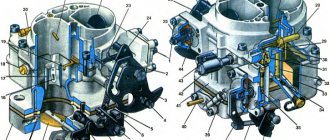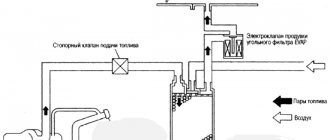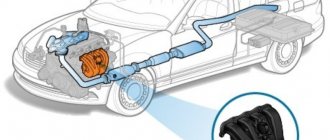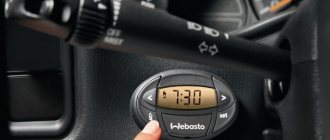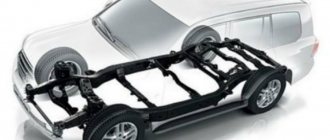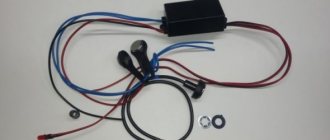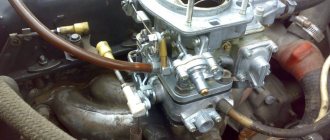Many car enthusiasts don’t even know what mono-injection looks like, because carburetor and injection engines are now used. But this system of supplying fuel to the cylinders also existed, and even now can be found on older cars. It was a transition between carburetor and injection engines. It is also called a monoinjector.
This system was used on German cars of the 80s, as well as on many Japanese ones. Meeting them now is difficult, but possible.
Like any device, an engine with such a fuel supply has its advantages and disadvantages, but modern designs have supplanted it. The reason is mainly due to environmental requirements, which have become much stricter.
Setting up mono injection in garage conditions
Required Tools
Before repairing the Passat B3 mono-injection unit, you must first prepare the necessary tools and additional accessories. Among them, in the process of work you may need the following:
- screwdriver;
- open-end wrenches;
- new spark plugs of the appropriate type;
- socket heads with collar;
- multimeter for taking measurements;
- sandpaper for cleaning contacts;
- electrical tape for working with wires;
- flat tongs;
- gasket for single injection (if it is damaged);
- distributor cover (if there are cracks).
Step by step guide
The repair process must occur in several stages:
- It is necessary to check the resistance of the air temperature sensor that enters the system. To do this you need to use a multimeter. The values obtained with its help should be compared with the normal values that are indicated in the manual for using the car. If the temperature range is from 20 to 25 degrees, then the resistance should be in the range of 1800-1900 Ohms. As the sensor heats up, you should see a decrease in resistance. By cooling it increases. This needs to be checked using a multimeter, independently raising and lowering the temperature.
- The next stage of repair is checking the resistance on the mono injector nozzle. In the working position it can range from 1.2 to 1.6 Ohms. Due to the fact that the multimeter does not measure very accurately, small errors in these indicators are still allowed.
- Next you need to adjust the idle speed. To do this, it is necessary to send a voltage of 12 V from the battery to the contacts of the regulator. At the same time, the accelerator should be set to its extreme position. Then we check for the presence of a short circuit (SC). To do this, the probe must be placed in the gap formed between the accelerator end and the rod itself. It is worth understanding if the gap is too significant. the multimeter will not be able to show the presence of a short circuit. In such a situation, adjustment or adjustment of the injection device on (VW) Volkswagen Pasat B three is required. To do this, you need to use a special screw located at the bottom of the assembly. With its help you can control the position of the limit switch.
- Once the driver has successfully adjusted the mono-injection, he needs to clean it and carry out other work of the same kind. Only after this can you begin to adjust the position of the throttle valve of the unit. In order to do this, you need to connect a monoinjector. The injector connector should be connected to it. Then you need to connect the position and temperature sensor connector. Next, you need to move on to installing the fuel lines in their correct position. The driver should disconnect the terminals from the battery. Once this is done, the key must be turned in the ignition. This way you can reset all previous settings. In the end, all that remains is to connect the battery.
A Volkswagen Passat B3 repair video can significantly simplify the process.
It is also worth paying attention to the fact that after resetting the monoinjector system, you need to check the voltage at the damper connector. Measurements must be taken on two contacts - No. 1 and No. 5
In this case, the ignition in the car must be turned on. The multimeter readings, as a rule, in this case are as follows: from 5 to 6 Volts. If you switch to other contacts - No. 1 and No. 2 - the device should show 0.186 Volts. Otherwise, it is necessary to make new adjustments to the system. It is quite possible that the first setup of the node was unsuccessful.
To fix the problem, you need to open screw No. 4 on the throttle cover. Then you should connect a multimeter to contacts No. 1 and No. 2. After this, the lid must be rotated for some time, determining the voltage in its different positions. It is necessary to stop when the indicators on the device coincide with the required ones. As a result, the problems with turnover should go away.
Setup Tips
Setting up a single injection is most often required when the engine speed fluctuates. This can be observed both at idle and while driving. Engine malfunctions are most noticeable when changing gears. All these symptoms indicate that adjustment of the mono-injection will be required in the near future.
Carrying out the adjustment
Description of the sequence of actions:
- Using a multimeter, check the resistance of the intake air temperature sensor and compare it with the table values;
Intake air temperature sensor - Check whether the sensor circuit is operational;
- Check the pressure of the injectors;
- Set the idle clearance;
- Check the accelerator regulator and limit switches;
- Adjust the throttle position.
Once the adjustment is complete, you need to start the car. A test drive should show no floating rpm. Otherwise, it is necessary to additionally check the associated systems.
Maintaining a single injection in good condition is only possible with high-quality diagnostics. It is necessary to pay attention to any changes in the behavior of the car. The sooner a problem is noticed, the cheaper it will be to fix it. It is necessary to pay regular attention to injection.
What is a single injection system, and what is the principle of its operation?
In short: the mechanism forces the supply (injection) of fuel into the cylinder.
It should immediately be noted that modern cars use two types of such systems:
- Single injection is, in fact, the main theme of our story. It differs in that 1 nozzle is used for injection, which “serves” all cylinders.
- Multipoint injection. We will not consider it separately now; we will only note the difference: in such a system, each cylinder is “served” by a separate nozzle.
Now let's take a closer look.
The system is a mechanism (not too complicated and large, by the way), which is located in the same place where the carburetor was (on the intake manifold in front of the cylinder). Its task is to supply fuel in the right quantity.
At the right moment (determined electronically, as mentioned above), the system delivers a stream of fuel into a small crescent-shaped hole. It is located between the body and the throttle valve.
Mixture formation occurs here due to the pressure difference - this prevents fuel from settling on the intake manifold. The nozzle itself operates at excess pressure (1 bar). The injection moment itself is synchronized with the ignition pulse.
principle – Mono-injection of the Mono-Jetronic system
electronically This is a controlled single-point low pressure injection system for 4-cylinder engines, a feature of the mono-injection is the presence of a central fuel injector, the location of which is controlled by a solenoid valve. The system uses a throttle body to meter intake air, while atomized fuel injection is performed above the throttle body. Fuel is distributed to the cylinders in the intake manifold. Various sensors monitor all their main operating characteristics; engines are used to calculate control signals for injectors and other actuators. Operation.
central injection unit system The injector is located above the throttle valve. The fuel jet is directly directed into the crescent-shaped hole between the body and the throttle valve, where, due to the large pressure difference, optimal mixture formation is ensured, eliminating the possibility of fuel deposition on the walls of the intake tract.
The injector operates at an excess pressure of 1 bar. Atomization allows the fuel to obtain a homogeneous mixture distribution under even full load conditions. Fuel injection through the injector is synchronized with the ignition pulses.
System operation control
In addition to the rotational speed of the crankshaft, the main variables on which the operation of the mono-injection system depends include the following: the volume ratio of air to its mass in the flow, absolute pressure in the pipeline and the position of the opening angle of the throttle valve. Compliance with the ratio of the throttle valve opening angle to the crankshaft speed in the Mono-Jetronic mono-injection system can ensure compliance with even the most stringent requirements for the content of toxic substances in exhaust gases, when this feedback system is used - with an oxygen sensor (lambda probe) and a three-component catalytic converter. The signal from the lambda probe, supplied to the adaptive system itself, is used to compensate for changes in operating conditions, and the engine to maintain stable operation throughout its service life.
Adaptation functions
During cold engine start-up, as well as directly after start-up and in warm-up mode, the fuel injection time increases to enrich the air-fuel mixture. When the engine is cold, the throttle valve actuator sets the position at which more mixture is supplied to the engine, thus maintaining the engine speed at idle speed and the content of harmful substances in the exhaust gases at a constant level. A potentiometer attached to the throttle valve axis fixes the position of the throttle valve and, based on the data from these ECUs, increases the amount supplied. In the same way, the fuel system ensures enrichment of the working mixture during acceleration and in full mode. The forced idle throttle ensures that fuel is cut off. Adaptive control of the crankshaft speed at idle allows you to stabilize and reduce the speed. The ECU, with the help of drive devices, ensures that the throttle valve position corresponds to changes in engine speed and temperature.
How the system works
Mono injection, in addition to the nozzle, consists of a temperature sensor, regulator and fuel return line. Compared with modern parameters, single injection requires very little pressure.
Principle of operation:
- The nozzle through which fuel is directed into the chamber is opened by a special controller.
- The fuel dosage is controlled by a valve, and the air supply is controlled by a throttle valve (DZ), controlled by an electric drive. The finished fuel assembly ends up in the cylinder that opened earlier than the others.
- Pressure stabilization is carried out by a regulator of the same name. It does not allow air pockets to enter the system when the internal combustion engine is turned off. Thanks to this design solution, starting the engine is easier.
An injector is an electromagnetic valve that provides fuel injection in pulses. It consists of a spray nozzle, spring, valve and solenoid.
What is a single injection, principle of operation, differences from an injector
66Everyone probably knows that there are two types of gasoline engines: an injector and a carburetor. But there is another one that doesn’t come across often, this is a mono injection, the principle of its operation is similar to both an injector and a carburetor. Mono injection is one of the options for injecting fuel into an internal combustion engine. Its characteristic feature is the supply of fuel to a chamber common to all cylinders. The air-fuel mixture is mixed in it and sent to the cylinder that is in the open state.
At the moment, there are no cars with one fuel injector being produced, but you can find a relatively large number of older cars operating on this principle.
Mono injection was developed and put into operation as automakers moved away from carburetors. First, they invented the single-injector system, and later the distributed injection for each cylinder, which is used today.
The design of the device directly includes a nozzle operating under pressure, an air temperature sensor, a fuel pressure regulator and a fuel return line. According to modern standards, the fuel pressure for single injection is quite low. An electronic controller is used to control the opening and closing of the nozzle. The solenoid valve is responsible for dosing fuel, and the throttle valve is responsible for dosing air.
The pressure regulator in the single-injection system performs the task of stabilizing the pressure and preventing the passage of air pockets after the engine is turned off (this makes it easier to start the engine in the future).
The key difference between a single injection and a distributed injector is that it uses one nozzle for all cylinders. A distributed injector has nozzles on each cylinder separately. Thanks to this, when using it, fuel is consumed more economically. In addition, the use of a common injector reduces the life of the engine.
The point is this. If the injector starts to work incorrectly, a poor fuel-air mixture is created, engine performance deteriorates, additional carbon deposits appear, moisture gets inside the combustion chambers, etc. Thus, deterioration of the injector affects the entire cylinder block. In the case of distributed fuel supply, wear of one of the injectors affects the operation of only one cylinder.
Compared to carburetor systems, mono-injection allows you to quickly start the engine due to a special valve that starts all the necessary processes.
Fuel injection systems (including single injection) do not suffer from such typical carburetor diseases as frequent clogging, clogging of jets, needle sticking, and the need for adjustment according to mileage.
Source
The ignition system on engines with single injection is quite simple.
And it is not difficult to diagnose it if you have an oscilloscope. Maybe that’s why many specialists cannot repair Monicas because they don’t have an oscilloscope?)
We connect the signal probe to the minus of the ignition coil,
Original ignition coil
we start it (or turn it with the starter), sharply accelerate it a couple of times and watch the recorded signal.
There must be a burning time for the spark
If the system is working properly, we see the standard picture
You can find out more about ignition diagnostics here.
Steel tips will pierce over time
A common malfunction in such cars is breakdown of the metal ends of explosive wires.
Broken wires also occur; this can be checked with a multimeter by measuring the resistance. Typically 15-30 thousand ohms.
Chinese ignition coil
When the “original” ignition coil or switch burns out - a large one like in the photo, then the Chinese ones fail very often or immediately do not work correctly.
Switch defects are common.
When the control signal to the ignition coil comes out before the input signal from the computer (commutator incontinence). This is especially clearly visible when the starter rotates, during the start of the internal combustion engine. After the engine starts, the switch can work normally.
Normal switch signal
With such a malfunction, it is difficult to set the ignition angle - at idle it seems normal, but when starting, the crankshaft “bites” - a characteristic sign of early ignition. We install the OZ later - the launch is normal, but when accelerating it fails...
Switch failure
Mono-injection systems are sensitive to early ignition timing.
If the RPM is too early, the engine runs intermittently and the idle speed may not be stable.
At the same time, sometimes people start changing the injection system sensors, and the reason is just an incorrect ignition timing.
On such cars it is convenient to check the ignition timing using an engine tester.
We use a cylinder pressure sensor and a minus signal from the ignition coil.
TDC and the beginning of the spark are clearly visible. Using a ruler or markers, you can determine how many degrees before TDC the gap between the spark plug electrodes breaks down. This is the real ignition timing.
In this picture, the SOP is 30 degrees BTDC
Optimal SOP: 11-14 degrees when rotating with the starter or 5-7 degrees at idle.
I won’t talk much about broken timing marks.
I note that when there is a flaw there, it is often visible that the atomized gasoline from the injector is pushed upward from the intake manifold.
It is also not uncommon on such engines when a key on the front crankshaft pulley is cut off. And there is just a mark stamped on it for installing the timing belt!
As a result, the mark on this pulley does not coincide with the TDC of the first cylinder. Therefore, it is more reliable to set the timing phases using the marks on the flywheel.
And of course, a motor tester will help a lot here.
So if:
- Everything is fine with the mechanical part of the internal combustion engine
- Ignition checked and adjusted
- There is no air leak, let's start checking the sensors...
Not “native” Lambda probe
Checking it is not difficult.
To do this you will need a multimeter or oscilloscope.
A working sensor supplies a signal to the ECU with a voltage from 0.2 to 0.8 Volts and this voltage should continuously move in this range.
Signal of a working, warm oxygen sensor
It is important to remember that the lambda probe only works when the engine is warmed up to operating temperature. If the internal combustion engine is not warmed up or the sensor is faulty, the voltage is usually 0.45 Volts or changes slowly
A faulty oxygen sensor can be turned off and the car drives fine without it in 90% of cases. Sometimes you have to adjust a little...
Repair and adjustment (with photo)
- The hood is opened, the mono-injection is unscrewed using a 10mm socket, and the gasket under it is replaced with a new one.
Single injection is removed with a socket head
- The contacts of the single injection sensor are carefully checked. If they are oxidized, they are cleaned with sandpaper.
- If problems are observed after replacing the spark plugs, the old spark plugs are returned to the engine and it is again checked for stability. If it turns out that the problem is in the spark plugs, another set of new spark plugs is installed in the engine (it is better if they are from a different manufacturer) and the test is carried out again.
- The distributor cover is replaced with a new one.
- The fuel pump is unscrewed and the throttle valve is cleared of soot.
The fuel pump has been removed, you can inspect the wires and sensor
- A visual analysis of the wires on the damper sensor is carried out and the integrity of their insulation and contact density are assessed. In damaged areas, the sensor wires are wrapped with electrical tape.
- As a rule, after some of the above actions, the problem of uneven injection is solved. But before installing it on a car, the mono-injection must be adjusted. Using a multimeter, the resistance at the outputs of the incoming air temperature sensor is measured. The measurement result is compared with the value specified in the car’s operating instructions (approximately: if the air temperature at the time of measurement is room temperature and is 25°C, then the resistance should be 1.8 kOhm).
The resistance at the sensor outputs is measured with a multimeter
- Next, the incoming air sensor is slightly heated using a conventional lighter, and the change in its resistance is monitored. If it decreases when the sensor heats up and increases when it cools, it means that the sensor is working and there will be no problems with it after installation.
- The same multimeter measures the injector resistance (on this Volkswagen model it varies from 1.3 to 1.6 Ohms).
- Now in single injection the exact idle clearance is set. A voltage of 12 V is supplied from the car battery to the contacts of the injection regulator. The accelerator is set to its extreme position. The multimeter switches to “short circuit” mode and its contacts are connected to the regulator on the accelerator. It is necessary to ensure that a small gap appears between the accelerator end and the rod, the width of which should not exceed 0.5 mm (this distance is checked with a flat feeler gauge, which is inserted into the resulting gap). A short circuit should appear on the multimeter. If it is not there, then the gap is too large and it is reduced using the adjusting bolt (it is located under the mono-injection).
- The throttle valve is now adjustable. The mono-injection unit is installed on the engine, the connector is connected to the injector. The damper position and incoming air sensors are also connected. Fuel pipes are connected. After this, the negative terminal is removed from the battery, and the key in the ignition is turned. This resets all settings in the on-board unit, including the damper position settings. They are automatically set to the manufacturer's default values. After reset, the negative terminal is reconnected.
The single injection is installed, the damper contacts are checked
- A multimeter measures the voltage on the fifth and first contacts in the damper connector (the ignition is on). It should not exceed 6 V. Then the multimeter switches to the first and second contacts of the damper connector. The voltage there should be 0.184 V.
This is how the contacts are located in the throttle connector of the Volkswagen Passat B3
- If these voltage values are not observed, then an adjustment is made: the 4 screws on the damper cover are loosened, the multimeter is connected to the first and second contacts of the connector, and the cover is turned either in one direction or the other. The voltage recorded by the multimeter changes. Once the position of the cover with the optimal tension is found, the bolts are tightened. This completes the adjustment.
Video about working with the system
As can be seen from this article, when repairing single injection on a Volkswagen Passat B3, the motorist will have to use the method of elimination, over and over again checking and discarding possible causes of uneven fuel supply until the real “culprit” is identified. This takes a lot of time, but it is the only way to accurately identify the cause of the problem. And then everything depends on the readings of the multimeter, which must be of high quality (it is strictly not recommended to use cheap Chinese devices when performing this work).
Signs and causes of malfunction
On the Volkswagen Passat B3, the mono-injection always starts to work poorly according to approximately the same pattern
All owners of this vehicle should pay attention to it. At first, the driver may notice that the engine speed begins to “float”, after which the engine reacts poorly to pressing the gas pedal
A similar problem occurs both when starting the engine and during the trip. Repairing the system in this case is quite short. Much more work needs to be spent on finding out the reason why the malfunction occurred.
As you can see from various videos on repairing the Volkswagen Passat B3, the car does not have a computer connection model. As a result, it is not possible to quickly diagnose the vehicle.
Among the most popular causes of malfunctions with a single injection system are the following:
- Loss of tightness of the gasket located directly under the assembly.
- Departure of contacts of wires located directly under the sensor.
- Replacing old spark plugs with new ones with their rapid failure after engine operation.
- Reduced sealing of the distributor cap (the problem may even relate to a microcrack invisible to the naked eye).
- The compression level is too high or low, which is created by the fuel pump.
- Clogged or dirty throttle valve.
- Damage to the wires that extend from the sensor, which are responsible for monitoring the throttle position.
A word from the expert opinion
Why are settings reset? Difficulties and an urgent need to “reboot” the unit arise among those who like to drive short distances. This problem is inherent to vehicle owners who prefer to regularly start the engine while simultaneously pressing the gas pedal. How to proceed?
- The engine starts and warms up. The cooling fan should operate twice. The optimal oil temperature is +80 degrees.
- We turn off the power unit by turning off the ignition.
- The connector from the control unit must be disconnected to clear the RAM.
- The above connector is turned on again.
Sources
- https://portalmashin.ru/service/engine/chto-takoe-monovprysk.html
- https://AvtoNov.com/%D1%87%D1%82%D0%BE-%D1%82%D0%B0%D0%BA%D0%BE%D0%B5-%D0%BC%D0%BE %D0%BD%D0%BE%D0%B2%D0%BF%D1%80%D1%8B%D1%81%D0%BA-%D0%B8-%D0%BA%D0%B0%D0%BA -%D0%BE%D0%BD-%D1%80%D0%B0%D0%B1%D0%BE%D1%82%D0%B0%D0%B5%D1%82/
- https://FB.ru/article/454806/nastroyka-monovpryiska-poshagovaya-instruktsiya-sovetyi-spetsialistov
- https://DriverTip.ru/osnovy/chto-takoe-monovprysk-kak-on-rabotaet.html
- https://scart-avto.ru/remont/chto-takoe-monovprysk-kak-on-ustroen-kak-rabotaet-i-chem/
- https://SwapMotor.ru/ustrojstvo-dvigatelya/monovprysk.html
- https://KrutiMotor.ru/nastrojka-monovpryska/
Requirements for setting up mono injection on an Audi
You can get to the unit by removing the air filter. It is necessary to inspect whether the gap of the idle air control limit switch is set correctly. How to act without errors?
- Auto ignition turns off. The block is removed from the IAC connector. 6V is supplied to the two contacts located at the top. The control rod should move in.
- To properly configure the Audi 80 mono injection, you should adjust the position of the shock absorber.
- A test instrument is connected to the two contact outputs of PXX at the bottom. It is more convenient to use a device that can make sounds: a short circuit is easier to detect.
- Now it's up to the 0.45 and 0.5 mm probes. They will act as assistants in measuring the distance between the throttle screw and the PXX rod. A short circuit should occur when a half-millimeter probe is inserted. This should not happen when using the second probe.
- A control measurement in setting up the Audi mono-injection is important for the normal functioning of the unit. In this case, there is no need to use the IAC connector. The ignition is turned on and the potentiometer helps measure the reference voltage. The malfunction can be judged by readings other than 5V. If there is a slight difference, for example, 0.2 V, we can talk about problems in the electrical network. It is better to contact specialists for qualified diagnostics in order to definitely find out the causes of defects or to adjust the operating mode of the structure.
Device
The single injection device is a complex mechanism that requires some attention, and its study requires time. To ensure air dosing during the creation of the fuel mixture, a throttle valve is used. In a special pipeline, fuel is distributed among the cylinders.
Differences between mono injection and distributed injector
- A distributed injector is a special power system with injectors: their number corresponds to the number of cylinders. Which option is better is up to the driver to decide.
- Single injection is a more outdated option, unlike a distributed injector.
- A distributed injector is more economical than a single injection system.
- A distributed injector can have direct and distributed fuel supply.
Considering this mechanism for supplying fuel to the engine, it can be noted that there are certain differences from a distributed injector. And all these differences from a distributed injector are justified by the use and preference of a specific system, which is different for each driver.
Differences between mono injection and carburetor
Mono injection is a method of supplying the mixture through one nozzle to all cylinders. It's better than a carburetor. Using a special valve that provides control of all processes, you can easily start the engine, which cannot be said about carburetor systems. This structure makes this option preferable. Possibility of reducing fuel consumption: carburetor elements are designed to make it higher due to incorrect settings; using the method under consideration, this figure can be significantly reduced. According to this parameter, the scheme under consideration is better than others. There is no need to manually configure the system to operate the engine. If the same thing happens in the carburetor circuit or in the area of the distributed injector, you may need the help of specialists. More advanced performance indicators associated with the highest accuracy of the operation of the circuit - pressure, voltage, etc. As a result, optimal dynamic characteristics of the engine and other mechanisms are achieved. The main thing is to check the pressure in a timely manner and carry out work to normalize this indicator.
It is also important to compare the voltage.
This system ensures high quality engine operation and creates optimal conditions for its functioning - normal pressure and others. Which type of device is better is up to each user to decide for himself.
Disadvantages of the system
The description of this type of filing suggests the existence of certain disadvantages:
- High cost of purchasing components and carrying out repair work. Traditionally, no driver, when purchasing this fuel supply system, expects breakdowns, but you need to be prepared for anything.
- Low suitability of many elements for repairs. Of course, this event is cheaper than a complete replacement, but this does not exclude its high cost.
- The need to purchase quality gasoline. In our country it is not always possible to purchase it, which is due to the sale of low-quality liquids by many gas stations.
- Severe dependence on electrical power. On this issue, the injector and carburetor system win, since the process is simpler.
Injection system malfunctions
The main malfunctions most often encountered on cars with single injection include:
- problems with the nozzle, its clogging or wear;
- incorrect operation of electronics.
The causes of the malfunction may be:
- natural wear and tear of fuel system elements;
- a manufacturing defect that can appear either immediately or after a certain period of time;
- unfavorable operating conditions, for example, refueling with low-quality gasoline, will, at best, cause clogging of the injector;
- faulty regulator;
- a sporty driving style that places critical loads on the engine and injection in particular.
To carry out diagnostics, you need to connect a laptop with special software installed. The good thing about a car with brains is that, if you have the right software for reading information, a tablet with a smartphone is also suitable. The obtained characteristics of engine operation allow us to narrow down the scope of troubleshooting.
Many car owners, in the absence of the opportunity to use a personal computer, act on the principle “I’ll check with an external inspection.” You can carry out any manipulations with the mono-injection only if you are confident in the performance of all other car systems. Some breakdowns, for example, if the sensors have oxidized contacts, can be determined by visual inspection. We clean oxidation and dirt without excessive effort.
After the car owner has cleaned the injector and sensor contacts, a test run is required. You should not interfere with the operation of the ECU. If it is impossible to fix the problem, it is advisable to contact professionals from the service center.
Single injection system diagram - description of key points
In principle, the system diagram has already been briefly described above. In the process of reading this is enough - for a more detailed study of the issue it is better to use a clear example.
However, we will still consider the scheme of operation of this system, considering the key points.
The design includes the following parts:
- Central nozzle. It is she who makes the injection.
- Throttle valve. Provides the right amount of air to form the mixture.
- Servo. The task of the part is to monitor the stability of the idle speed by forcing the throttle valve to open.
- Entrance sensors. Used to collect data on the operation of all engine components.
- Control unit (electronic, of course). Manages the system. It consists of a processor and a memory unit (containing data on the operating mode at different numbers of revolutions).
- Pressure regulator. Provides support for the required pressure (0.1 MPa) and prevents the appearance of air locks.
Now let’s talk about how the system works.
The control unit, which receives data from all sensors, compares them with the data stored in the memory by the manufacturer. By calculating the difference, the result is the required amount of fuel and air that is needed to create the fuel mixture that should be used at the current operating mode.
The calculated data is used to calculate the torque and duration of injector opening and the throttle opening angle.
How does the vehicle's central supply system work?
Operating principle of the engine cooling system
The mono injection system has a convenient and understandable design. It may consist of the following elements:
- central fuel injection nozzle;
- throttle valve;
- electric servo drive;
- entrance sensors;
- electronic control unit;
- pressure regulator
Central nozzle
The main purpose of the injector is to provide fuel injection. This is a small magnetic valve that opens using electromagnetic pulses sent by the control unit. The injector itself consists of a coil, a return spring, a nozzle for spraying fuel and a shut-off valve.
Throttle valve
The damper is used to adjust the required volume of air mass that enters the chamber. The damper can be adjusted mechanically or electrically.
Servo
The electric throttle servo drive ensures a stable idle speed, which is achieved by forcing (opening) the throttle valve.
Pressure regulator
The main purpose of the regulator is to maintain the required pressure inside the system - 0.1 MPa, and also to prevent the formation of air pockets in the combustion chamber after the engine is turned off. The absence of air pockets is the key to easy engine starting.
Control block
The unit allows you to control the central injection system through a central injector and a servo drive. The unit consists of a processor and a memory unit, which contains information about all the important characteristics of fuel injection at various engine speeds.
Entry sensors
Sensors record changes occurring in the operation of all main and auxiliary elements of the internal combustion engine. Input sensors include injection sensors, air and coolant temperature, engine speed, oxygen level, and turning off the electric servo drive.
Each of the sensors is designed to perform its own function.
So, using sensors for measuring air temperature and the initial position of the damper, you can calculate the required volume of air that will be supplied to the fuel injection system.
Air temperature is measured because the density of the air mass, and, consequently, its weight per unit volume, depends on it. The colder the air, the heavier and denser it is. The temperature sensor is installed under the central nozzle.
The throttle position sensor transmits data on how much air should be supplied through the throttle valve. It is installed on the damper drive axis.
The volume of air mass is adjusted by setting a certain position of the damper, due to which the area of the passage channel changes. The greater the throttle opening angle, the more air will enter the engine cylinder.
If for some reason both of the above sensors fail, their functions will be performed by sensors measuring speed and coolant temperature (antifreeze or antifreeze).
The supply and then ignition of the fuel mixture occurs based on electronic signals sent by the injection timing sensor.
When the engine is idling, the servo drive switch-off sensor ensures uninterrupted operation of the injection system by sending a corresponding signal to the damper servo drive in a closed state (indicating XX mode), setting it to the required angle.
Oxygen sensor – a sensor that measures the oxygen level and maintains the required level and ratio of all components of the fuel assembly. Often it is installed directly in the exhaust manifold or in front of the converter (catalytic converter).
You may also be interested
Be sure to check the installation of the timing marks, set the ignition strictly according to the manual, no matter that your car does not drive with this ignition, on the Monomotronic MA1. Check for errors there should not be any errors, it is advisable that there should be no TPS either
We set the voltage between 1 and 2 to be equal to 0. All the following adjustments should be made with the power consumers turned off, even when the fan is turned on, there is no need to adjust anything as all the variables begin to float away!!!
It should not be desirable to check for errors; it is advisable that there should not be any TPS either. We set the voltage between 1 and 2 to be equal to 0. All the following adjustments should be made with the power consumers turned off, even when the fan is turned on, there is no need to adjust anything as all the variables begin to float away!!!
Do not turn the TPS quickly; the system reacts very slowly to turning the TPS and it takes some time for everything to stabilize; usually 10 seconds is enough, tighten the sensor bolts and watch the readings; they usually float away if we repeat the adjustment this way.
The data converges, everything is ok, it doesn’t converge, we change the sensor, there are no connections, we connect the wires to the sensor, it’s possible that it’s just a break and a soldering iron can fix it with a bang. The injector is checked by measuring the resistance from the central contacts of the brown terminal on the single injection. The resistance should be 1.
And then we begin the main entertainment. Carefully inspect your mono-injection for the presence of seals; they should be on 1.
This excerpt (second) is taken from the article: https://pol-z.ru/samostoyatelno-remontiruem-monovpryisk-na-volkswagen-passat/
Features of the operating principle of single injection
The principle of preparing the air-fuel mixture is simple. The injector, controlled by the ECU, dispenses the required amount of fuel, and the throttle valve supplies the required air. The combustible mixture is distributed among the cylinders using special sensors.
Gasoline is supplied to the combustion chamber between the engine body and the throttle valve. To ensure good performance characteristics, ignition and mono-injection work harmoniously. This became possible thanks to the management of all processes from a single controller.
The operating mode of the fuel system is influenced by the following factors:
- crankshaft rotation speed;
- ratio of components of the fuel-air mixture;
- throttle position;
- gasoline pressure in the fuel line.
Mono-injection control has a lot of negative feedback coming from sensors. All information received by the ECU serves to reduce emissions of harmful substances and improve the dynamic performance of the vehicle. On a technically sound car with single injection, the exhaust fully complies with modern environmental requirements.
What is mono injection in a car?
The main feature of this system, which is where the name comes from, is the use of only one nozzle. The fuel mixture is injected into a common chamber, and from it enters the cylinder in which the valve is open.
Now cars running on gasoline use distributed supply, when the mixture is supplied to each cylinder individually, by a separate nozzle. But this consumes more fuel.
Single injection device
The design and operating principle of this system are quite complex and differ from other, more popular ones. Its operation is supported by a large number of sensors that regulate the fuel supply, but this makes it easy to start a cold engine.
A single nozzle is installed above the throttle valve, which regulates the air supply. Fuel is injected between the housing and the valve, and this process is synchronized with the ignition.
Sensors are used to dose fuel at different engine operating modes. The opening of the nozzle is controlled by an electronic controller, and its quantity is dosed by an electromagnetic valve. The mixture from the common chamber one by one enters the cylinders when the corresponding valves open, where it ignites.
Principle of operation
In general, it’s not difficult to understand how mono injection works. The process consists of several stages.
- Sensors, depending on the engine operating mode, regulate the amount of fuel that the injector will produce.
- The fuel enters through the nozzle into a common chamber, where it is mixed with air.
- The finished mixture enters the first opened cylinder.
- Excess unused fuel is returned through the return line.
The nozzle has a spray nozzle and a shut-off valve. Fuel supply occurs in pulse mode, controlled by an electromagnet. The air supply is controlled by a throttle valve, which in turn is controlled by a mechanical or electrical drive.
But in reality, mono injection requires careful adjustment and synchronization. In addition, such a device is difficult to repair, and these are important reasons why such a scheme has not become widespread.
Single injection device
Revolutionary in the emergence of the new fuel system was the abandonment of the use of a carburetor and the installation of an injector. The idea itself was not new, but the implementation of mono-injection brought engineers closer to creating modern injection systems. The main distinctive feature of the technical solution under consideration was the use of a single nozzle that sprays fuel. Otherwise, the operating principle of single injection is similar to current fuel systems.
Single injection structure
The single-point injection system worked with fuel at low pressure by modern standards. The opening and closing signal came from the electronic control unit. There is an electromagnetic valve inside the injector, which is responsible for dosing gasoline. The mono-injection throttle valve is responsible for regulating the amount of supplied air.
Pros and cons of mono injection
The main advantages of using single injection to supply fuel to the engine are:
- Simple and quick engine start (compared to carburetor options).
- Reducing fuel consumption with increasing engine efficiency, both when the vehicle is moving and when starting and idling.
- There is no need to adjust the fuel supply system and create the fuel-air mixture manually. Everything is adjusted automatically in accordance with data from temperature, oxygen, etc. sensors.
- Single injection, like other injection systems, has a reduced level of carbon dioxide emissions into the atmosphere.
- Unlike an injector, a mono-injection has a simpler design.
At the time of its introduction, mono-injection became a system that made it possible to “put” even more ordinary people behind the wheel, far from understanding the internal processes of the car. Now the composition of the fuel mixture was automatically regulated, reducing fuel costs, improving efficiency and reducing engine wear. Previously, in the era of carburetor engines, fuel consumption depended on settings that had to be set manually and adjusted depending on driving style, road conditions, engine behavior and other factors.
But today single injection is an outdated technology, inferior to systems with distributed fuel injection in almost everything:
- Components and spare parts for mono-injection are rare and expensive. For some elements it is no longer possible to find a replacement.
- Deviations in fuel quality lead to a strong “floating” of engine speed.
- To diagnose, repair and configure a single injection, special equipment is required, which is not advisable to purchase for garage use.
- In single injection, the fuel-air mixture remains in the chamber for different times and travels different distances before entering the cylinder. This reduces the quality of its combustion and increases the cost of gasoline.
In general, distributed injectors are modern fuel systems that are less demanding on fuel quality, reduce wear on system elements, and make engine operation more stable and useful (in terms of efficiency).
Disadvantages of using one nozzle
The current lack of serial production of single injection is due to a number of shortcomings that have not allowed it to emerge victorious in the competition. The main disadvantages of the system under consideration are:
- high cost of components, especially compared to the carburetor power system;
- low maintainability, associated both with the design features of the units and with the small number of specialists capable of repairing a single injection unit;
- The speed fluctuates greatly with any deviations in fuel quality;
- inability to start the car with a discharged battery, since the mono-injection system is controlled by an electronic controller;
- Diagnostics, repair and adjustment of mono-injection are very difficult in garage conditions, as they require special equipment.
If the car does not start, then with a carburetor power system, the car owner will check whether the fuel is overfilled and can start the engine. In the case of single injection, only a few know how to adjust the fuel supply, so checking the performance of the system becomes an incomprehensible task for most. The complexity of the electrical circuit has made it impossible to test it with a multimeter; now the fault can only be identified by connecting a diagnostic scanner.
Setting up a single injection system
It should be said right away that it is strongly not recommended to change the system settings yourself! The manufacturer sets the optimal operating mode, and your intervention can only aggravate the situation. Not every car service worker will take on such delicate and responsible work.
Moreover, the mono-injection is practically not regulated in any way. And why bother tuning it - only one injector does the job, and if any problems are observed (more on them later) - you need to go to a service station and/or change the system itself.
By the way, it should be said separately that adjusting the mono-injection system will not allow you to reduce fuel consumption (as some often believe): it has already been said above that everything is configured for the optimal mode, and you can only, on the contrary, increase consumption.
The only option you can try is to adjust the ignition timing (using a strobe and distributor). However, again, this will not give much improvement, and making a serious mistake is very, very easy.
To adjust the mono-injection system itself, special equipment is used - a broadband lambda, a logger with an acceleration sensor, a programmable ignition unit and a laptop. Specialists, of course, have all this, so it’s worth contacting them to set up and adjust the mono-injection.
Complexities and conveniences of both systems
In case of malfunctions in the operation of mono-injection systems, the sensors and injector coil must be checked. It is not difficult to identify a fault with a potentiometer ohmmeter, but it is expensive to replace. An original part may cost more than a used engine. The sensors must match the parameters exactly and, preferably, be tested on a known-good engine. The operation of the system can be disrupted by loaded “memory” in the control unit. But a tuned unit with working sensors will produce good results in engine operation.
In case of malfunctions, the carburetor is repaired mainly by eliminating mechanical damage, corrosion and dirt. As well as optimal adjustment of the adjusting screws.
Therefore, for those who are afraid of electronics like fire and, in case of some failures, rush to sell their car, it is better to recommend a carburetor. But if anyone wants their engine to work optimally and use its resource economically, sacrificing complexity, then it is better to choose the electronic option.
Auto and motorcycleComment
Advantages of the system
Advantages of mono injection over carburetor:
- simplified engine starting;
- fuel consumption is reduced while maintaining the same driving style;
- the mono-injection device eliminated the need to manually adjust the mixture supplied to the engine;
- reducing the amount of harmful substances in the exhaust as a result of a more optimal ratio of gasoline and air supplied to the combustion chamber;
- control by ECU.
One of the main advantages of cars with single injection was the absence of dependence of fuel consumption on the level of qualification and experience of the carburetor. The classic system, if the quality and quantity screws were incorrectly set, could burn gasoline several times more than normal, due to the low professionalism of the person who made the adjustment. In mono-injection, no intervention is provided during normal operation. Incorrect adjustment of a single-point injection system when troubleshooting does not have such a critical effect on fuel consumption.
Diagnosis of system faults
Has your car started to consume more fuel? Worried about black exhaust? Has there been a cutoff? Having trouble starting the engine? Interruptions during acceleration? Unstable speed and shaking at idle?
These are the most obvious signs that it’s time to change the mono-injection. Although, of course, the problem may lie elsewhere (in spark plugs, oil, injectors, for example), as practice shows, it is the control unit of the system that fails.
The problems may be caused by the following factors:
- natural wear and tear of parts;
- technical defects (admitted during production);
- improper operation of the vehicle (for example, driving on low-quality gasoline, which happens quite often, because at some gas stations it can simply be diluted);
- damage to the actuators (moisture getting into the electronics, mechanical damage).
The most effective way to identify a problem is to use computer diagnostics. To do this, a computer or a special scanner is connected to a special connector, which reads information from the memory of the control unit.
The resulting code is easily deciphered using the specified values, which are set for each system and are indicated in the list of faults.
Operating principles of single injection
Car owners are often interested in setting up a single injection, so you should study its operating diagram.
- By pulse movements, the nozzle, which is an electromagnetic valve, releases fuel into the chamber. That, in turn, is controlled by the control unit.
- The fuel-air structure moves into the first opening cylinder. Air volume and pressure parameters are regulated by sensors.
- Excess fuel travels in the opposite direction along the built-in highway.
You may be interested in: Amtel tires: types of tires, their features and reviews from owners
Before setting up a single injection from scratch, it is necessary to inspect the integrity of the meters; at the same time, it does not hurt to check the tester - an important element in the work. Not everyone understands how this device differs from injectors.
The concept of single injection
Single injection is a type of injection system. Its distinguishing feature is related to the fuel supply. It first enters a chamber common to all existing cylinders, and once in the chamber, it is mixed with air. The resulting mixture enters the cylinder, ready to receive it.
The mono-injection system was invented as an alternative to carburetors. First, they invented a single-injector design, and then they began to produce distributor injection designed for each of the cylinders. Today there are very few cars left with single injection, but they still remain in operation.
On a note!
Cars with single injection are completely out of production.
Advantages and disadvantages
Single injection has been discontinued because it has certain disadvantages and is inferior in many respects to the injection system. However, it also has a number of advantages:
- Mono injection is superior to carburetor systems in terms of efficiency. It allows you to start the engine faster due to a special valve responsible for the switching process.
- All injectors, including mono-injectors, do not have the problems characteristic of carburetors - clogging, clogging of jets, the need for adjustment so that the system does not burn too much fuel.
- Monoinjectors are characterized by reduced emissions. They emit less carbon dioxide and are not as harmful to the atmosphere as carburetor cars.
Once upon a time, mono injection was positioned as a convenient system that relieved drivers of manual settings. Now the monoinjector is an outdated design, inferior to the distribution system.
Minuses:
- the high price of spare parts and it is quite difficult to find them;
- due to poor fuel quality, there is a “floating” of engine speed;
- repair of a single injection requires special equipment, which is completely unprofitable to purchase for individual use;
- The fuel assembly stays in the chamber for different times and travels different distances before it enters the cylinder, so its quality decreases and consumption increases.
On a note! Mono injection is inferior to injectors in terms of fuel economy, and its single nozzle reduces the operation of the internal combustion engine.
System check
The single-injection system is reliable, in many ways superior to carburetor systems, but it can sometimes fail. Single injection malfunctions can result in an unpleasant surprise
Therefore, it is important and necessary to know how to check the system and what to be prepared for. Unfortunately, it is not possible to assess the condition of the electronic control unit at home.
If a system malfunction is detected, you must proceed according to the following algorithm:
- Make sure the ignition is working.
- Check fuel supply.
- Carefully inspect all the parts of the single injection and make sure the fuse is intact.
- If after taking these steps no fault is found, refer to the diagnostic system memory.
- The diagnostic system light is located on the dashboard and will light up in a specific rhythm, depending on the nature of the violation.
The fault data will be stored for eight engine starts, after which it will simply be erased. Testing in this way will allow you to identify no more than one malfunction of the system each time. That is, for each malfunction a separate diagnosis is required. In those cars where there is no diagnostic lamp, the information is read by a voltage meter.
Generations of systems
- Carburetor. They had many shortcomings, so they are classified as the first generation. There were frequent cases of fires and pops.
- Single injection - the system could be used not only on a carburetor engine, but also on an injector. A cold “start” has appeared, making the startup process easier.
- Distributed injector. Combines the positive qualities of previous systems and is improved.
